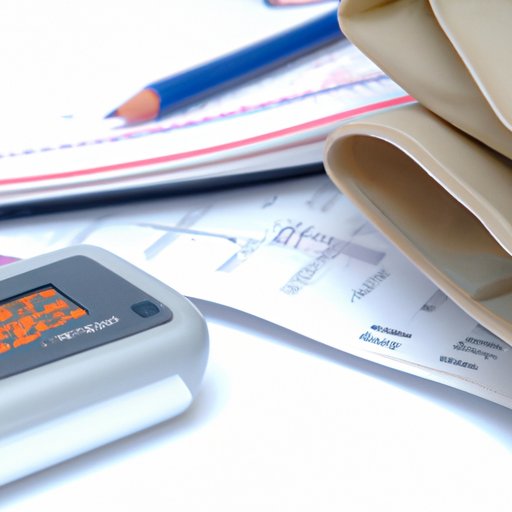
I. Introduction
High blood pressure, or hypertension, is a condition that affects millions of people worldwide. It can lead to serious health problems if left untreated, including heart disease, stroke, and kidney failure. Fortunately, there are many things you can do to lower your blood pressure and improve your overall health.
This article will provide you with a comprehensive guide to lowering your blood pressure. We’ll cover the importance of diet and nutrition, how exercise can help, the benefits of quitting smoking, stress reduction techniques, monitoring your blood pressure, and medication. We’ll also discuss the importance of making lifestyle changes over time and provide strategies for setting and achieving goals.
II. Diet and Nutrition
A healthy diet is essential for managing blood pressure. The American Heart Association recommends a diet rich in fruits, vegetables, whole grains, low-fat dairy products, poultry, fish, nuts, and beans. It also suggests limiting saturated and trans fats, red meat, and added sugars.
Specific dietary recommendations for lowering blood pressure include reducing sodium intake, which can be achieved by avoiding processed foods and choosing low-sodium options. Also, try incorporating more fruits and vegetables into your diet. These are naturally low in sodium and high in nutrients that support healthy blood pressure. Foods containing potassium, like bananas, avocados, and sweet potatoes, are also beneficial.
Another thing to consider is the role that caffeine plays in increasing blood pressure in some people. Limiting caffeine intake by drinking decaffeinated coffee or tea or swapping for water can also help lower blood pressure.
III. Exercise and Physical Activity
Regular exercise can provide many benefits for blood pressure, including reducing resting blood pressure and improving blood vessel function. Aerobic exercises like brisk walking, cycling, or swimming are excellent for improving cardiovascular fitness. Strength training exercises like push-ups, weight lifting, and resistance band training are also beneficial for maintaining muscle mass and reducing fat.
The American Heart Association suggests at least 150 minutes of moderate-intensity aerobic exercise per week, along with two days of strength training exercises. This can be broken down into shorter periods of activity throughout the week, making it easier to fit into even busy schedules.
IV. Quitting Smoking
Smoking is a significant risk factor for hypertension. When you quit smoking, your blood pressure may decrease by up to 10 mmHg. Cutting out smoking can also lower your risk of coronary heart disease, stroke, and other health problems.
Tips for quitting smoking include finding social support and professional help if needed. Nicotine replacement therapies are available, such as gum, patches, and lozenges, that can help manage withdrawal symptoms. Joining a support group or speaking with a healthcare provider can also provide additional tools needed to quit.
V. Stress Reduction
Stress is a contributing factor to high blood pressure. It can cause blood vessels to constrict and the heart to work harder, leading to an increase in blood pressure. There are many techniques you can use to reduce stress, including deep breathing, meditation, yoga, and tai chi.
Adopting a healthy lifestyle, balanced diet, regular exercise, and getting enough restorative sleep are also essential for stress reduction. Speak with your healthcare provider or try counseling and psychotherapy techniques to help manage stress effectively.
VI. Monitor Your Blood Pressure
Measuring blood pressure at home provides people with the opportunity to monitor and track their levels regularly. It is easy to learn how to do this at home and a convenient option when visiting your healthcare provider is not possible. Many drug stores offer free blood pressure checks.
The American Heart Association suggests that people monitor their blood pressure at home, write down their numbers, and share them with their healthcare provider. Doing so can provide more comprehensive health care and better communication between patients and practitioners. It helps doctors adjust medications and make necessary changes to the treatment plans.
It’s essential to understand what the numbers mean and know when to seek medical attention. A blood pressure reading of 120/80 mmHg is considered normal. Anything higher than this may be cause for concern and require medical attention. The top number represents Systolic Blood Pressure (SBP ), and the bottom number represents Diastolic Blood Pressure (DBP).
VII. Medication
If lifestyle modifications are insufficient or ineffective, healthcare providers may prescribe medication to help lower blood pressure. There are many medications available, including diuretics, angiotensin-converting enzyme inhibitors (ACE inhibitors), angiotensin II receptor blockers (ARBs), beta-blockers, calcium channel blockers, renin inhibitors, and alpha-blockers.
It’s critical to understand how the medication works and be aware of possible side effects. Always follow the prescribing guidelines and speak with your healthcare professional regarding dose adjustments.
VIII. Lifestyle Changes
Lowering blood pressure requires making lifestyle changes that are consistent and achievable. It’s essential first to go at your pace, setting small goals and gradually increasing your targets over time. Consistent progress is more valuable than fast results in maintaining long-term success.
Strategies for setting and achieving goals include starting with small steps and focusing on one thing at a time before moving on to the next. You can challenge and engage yourself over time by shifting your goals higher, stepping up the workouts, or trying new healthy foods or hobbies.
IX. Conclusion
Lowering blood pressure requires a multifaceted approach, including dietary changes, regular exercise, and quitting smoking. It’s also essential to explore ways to reduce stress and monitor blood pressure levels regularly. Finally, working with a healthcare provider, taking medication as prescribed, and making consistent lifestyle changes can help improve overall health.
Remember that everyone’s journey will be different. It’s essential to stay motivated, set goals, and enjoy the process while working towards a healthier future. By taking these steps, you can improve your overall health and significantly lower your risk of heart disease, stroke, and kidney failure.
Additional resources for readers who want more information:
– American Heart Association
– National Heart, Lung, and Blood Institute
– Centers for Disease Control and Prevention
– Smokefree.





